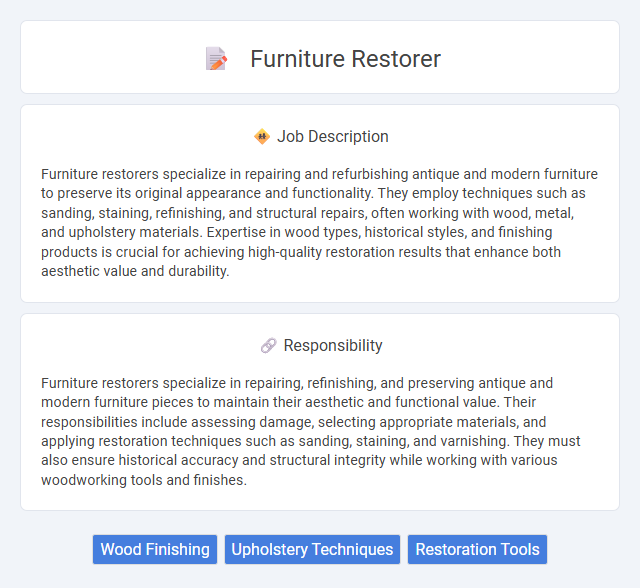
Furniture restorers specialize in repairing and refurbishing antique and modern furniture to preserve its original appearance and functionality. They employ techniques such as sanding, staining, refinishing, and structural repairs, often working with wood, metal, and upholstery materials. Expertise in wood types, historical styles, and finishing products is crucial for achieving high-quality restoration results that enhance both aesthetic value and durability.
Individuals with patience and strong attention to detail are likely to be well-suited for a furniture restorer role, as the job requires precision and care in handling delicate materials. Those who experience physical limitations, particularly in their hands or back, may find the repetitive and sometimes strenuous tasks challenging. Emotional resilience and a passion for craftsmanship probably increase suitability, given the often slow and meticulous nature of restoration work.
Qualification
A Furniture Restorer must possess expertise in woodworking, surface finishing, and knowledge of various materials such as wood, metal, and fabric. Proficiency in using restoration tools, paint matching, and historical furniture styles is essential to ensure accurate and high-quality repairs. Certifications in conservation techniques or apprenticeship experience enhance credibility and demonstrate a strong foundation in restoration practices.
Responsibility
Furniture restorers specialize in repairing, refinishing, and preserving antique and modern furniture pieces to maintain their aesthetic and functional value. Their responsibilities include assessing damage, selecting appropriate materials, and applying restoration techniques such as sanding, staining, and varnishing. They must also ensure historical accuracy and structural integrity while working with various woodworking tools and finishes.
Benefit
A Furniture Restorer likely benefits from enhanced craftsmanship skills and the satisfaction of preserving valuable or antique pieces. There is a probable opportunity for a flexible work schedule and potential for self-employment, increasing income control. Access to a niche market may result in steady demand and long-term client relationships.
Challenge
The role of a furniture restorer likely involves the challenge of accurately assessing the condition and history of various antique or damaged pieces to determine the best restoration approach. There is a probable need to balance preserving original materials with incorporating modern techniques to ensure durability and aesthetic appeal. Attention to intricate details and patience might be crucial to overcome difficulties posed by wear, age, and previous repairs.
Career Advancement
A Furniture Restorer specializes in repairing and revitalizing antique and contemporary furniture through techniques such as refinishing, reupholstering, and structural repairs. Career advancement opportunities include progressing to senior restorer roles, supervising restoration teams, or opening a specialized restoration business. Gaining expertise in historic preservation and advanced restoration technologies enhances prospects for leadership positions and collaboration with museums or high-end clients.
Key Terms
Wood Finishing
Wood finishing is a crucial skill for a Furniture Restorer, involving techniques such as staining, varnishing, and polishing to enhance the wood's appearance and protect it from damage. Expertise in wood finishing requires knowledge of various finishes like lacquer, shellac, and polyurethane, as well as the ability to match original colors and textures for authentic restoration. Precision in sanding, repairing surface imperfections, and applying coats ensures the longevity and aesthetic quality of restored furniture pieces.
Upholstery Techniques
Furniture restorers specializing in upholstery techniques skillfully repair and replace fabric, padding, and springs to revive antique and modern pieces. Mastery of methods such as webbing, stuffing, and tufting ensures structural integrity and aesthetic restoration. Expertise in selecting durable materials like horsehair, cotton batting, and natural fibers enhances the lifespan and comfort of restored furniture.
Restoration Tools
Furniture restorers rely on specialized restoration tools such as chisels, scrapers, and fine brushes to carefully remove old finishes and repair damaged surfaces. Precision sanding pads and carving knives are essential for detailed work, allowing restorers to preserve the integrity and original craftsmanship of antique pieces. The application of waxes, varnishes, and adhesives requires expertly chosen tools to ensure a seamless and durable restoration outcome.
 kuljobs.com
kuljobs.com